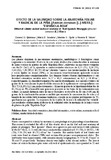Mostrar el registro sencillo del ítem
Efecto de la salinidad sobre la anatomía foliar y radical de la Piña (Ananas comosus (L.) Merr.) ‘Española Roja’
| dc.rights.license | http://creativecommons.org/licenses/by-nc-sa/3.0/ve/ | |
| dc.contributor.author | Quintana, Claravel G. | |
| dc.contributor.author | Sanabria, María E. | |
| dc.contributor.author | Ojeda, Maritza G. | |
| dc.contributor.author | Valera, Rosario E. | |
| dc.date.accessioned | 2012-07-30T14:23:20Z | |
| dc.date.available | 2012-07-30T14:23:20Z | |
| dc.date.issued | 2012-07-30T14:23:20Z | |
| dc.identifier.issn | 0554-2111 | |
| dc.identifier.uri | http://www.saber.ula.ve/handle/123456789/35673 | |
| dc.description.abstract | Las plantas disponen de mecanismos anatómicos, morfológicos y fisiológicos como respuestas a la salinidad. El efecto de este estrés abiótico fue evaluado sobre la anatomía de hojas y raíces de plantas de piña ‘Española Roja’, cultivadas en maceteros y regadas con NaCl+ CaCl2 (1:2), ajustadas a conductividades eléctricas de 0,75 (T1); 3,10 (T2); 5,40 (T3); 7,70 (T4) y 10 (T5) dS·m-1, durante 7 meses. Los tercios medios de las hojas y raíces fijados en etanol (70%), se seccionaron transversalmente aplicando técnicas para preparaciones semipermanentes. Las láminas foliares fueron hipostomáticas y con densidad estomática variable entre 54,77 a 38,25 estomas/mm2 en 0,75 y 10 dS·m-1, respectivamente. La densida tricomática fue mayor abaxialmente. Los menores valores de grosor de la cutícula mas la pared celular externa de la epidermis se correspondieron con T1 y T2 (1,29 y 1,32 μm, respectivamente). El mayor grosor de la hipodermis foliar fue de 61,53 μm en T3; el mesofilo más grueso se presentó en las hojas de los tratamientos más salinos. La menor distancia entre los haces vasculares se observó en T1 con 34,90 μm. El grosor de la rizodermis fue menor a medida que aumentó la concentración de sales y el tamaño de las células tuvo la misma tendencia, excepto en las plantas provenientes de T2, que fueron más grandes. La respuesta de los tejidos de la raíz a la salinidad fue variable. Los resultados evidenciaron el efecto de la salinidad sobre la anatomía de la hoja y raíces de plantas de piña ‘Española Roja’. | es_VE |
| dc.language.iso | es | es_VE |
| dc.rights | info:eu-repo/semantics/openAccess | |
| dc.subject | Densidad estomática | es_VE |
| dc.subject | Densidad tricomática | es_VE |
| dc.subject | Estrés salino | es_VE |
| dc.subject | Anatomía radical y foliar | es_VE |
| dc.subject | Conductividad eléctrica | es_VE |
| dc.title | Efecto de la salinidad sobre la anatomía foliar y radical de la Piña (Ananas comosus (L.) Merr.) ‘Española Roja’ | es_VE |
| dc.title.alternative | Effect of salinity on leaf and root anatomy of ‘Red Spanish’ Pineapple (Ananas comosus (L.) Merr.) | es_VE |
| dc.type | info:eu-repo/semantics/article | |
| dc.description.abstract1 | Plants can respond to salinity by anatomical, morphological or physiological mechanisms. This research evaluated the effect of this abiotic stress on the leaf and root anatomy of plants of pineapple ‘Red Spanish’. Plants were grown in pots and watered with solutions of NaCl + CaCl2 (1:2) with electrical conductivities adjusted to 0.75 (T1), 3.10 (T2), 5.40 (T3), 7.70 (T4) and 10 (T5) dS·m-1 for 7 months. The middle thirds of leaf blades and roots were fixed in ethanol (70%) and sectioned to prepare semi-permanent slides. The leaf blades were hypostomatic, with stomatal density ranging from 54.77 to 38.25 mm-2 in T1 and T5, respectively. Trichome density was higher in the abaxial surface. The lowest values of cuticle thickness plus outer cell wall of epidermal cells corresponded to T1 and T2 (1.29 and 1.32 μm, respectively). The thickness of the leaf hypodermis was higher in T3 with 61.53 μm, and the thicker mesophyll occurred in leaves of the most saline treatments. The distance between the vascular bundles was the lowest in T1 with 34.90 μm. The thickness of the rhizodermis was lower as the salinity increased. The same trend was observed for rhizodermic cell size, except in plants of T2, which were larger. The response of cortical tissue and the vascular cylinder of the roots to salinity were variable. The results showed that salinity effectively affected the leaf and root anatomy of pineapple ‘Red Spanish’. | es_VE |
| dc.description.colacion | 87-108 | es_VE |
| dc.description.email | claraq443@hotmail.com | es_VE |
| dc.description.email | mesanabria@ucla.edu.ve | es_VE |
| dc.description.email | mgojeda@ucla.edu.ve | es_VE |
| dc.description.email | rosariovalera@ucla.edu.ve | es_VE |
| dc.description.frecuencia | Anual | |
| dc.identifier.depositolegal | 196702ME558 | |
| dc.subject.departamento | Departamento de Botánica | es_VE |
| dc.subject.facultad | Facultad de Ciencias Forestales y Ambientales | es_VE |
| dc.subject.keywords | Stomatal density | es_VE |
| dc.subject.keywords | Trichome density | es_VE |
| dc.subject.keywords | Salinity stress | es_VE |
| dc.subject.keywords | Leaf and root anatomy electrical conductivity | es_VE |
| dc.subject.publicacionelectronica | Pittieria | |
| dc.subject.seccion | Pittieria: Artículos | es_VE |
| dc.subject.thematiccategory | Medio Ambiente | es_VE |
| dc.subject.tipo | Revistas | es_VE |
| dc.type.media | Texto | es_VE |
Ficheros en el ítem
Este ítem aparece en la(s) siguiente(s) colección(ones)
-
Pittieria No. 36
Enero - Diciembre 2012


